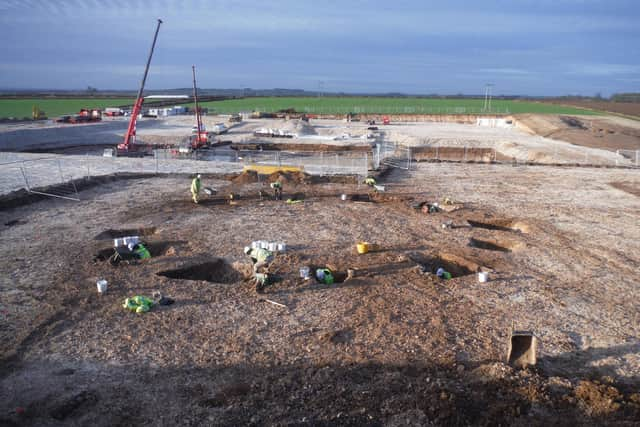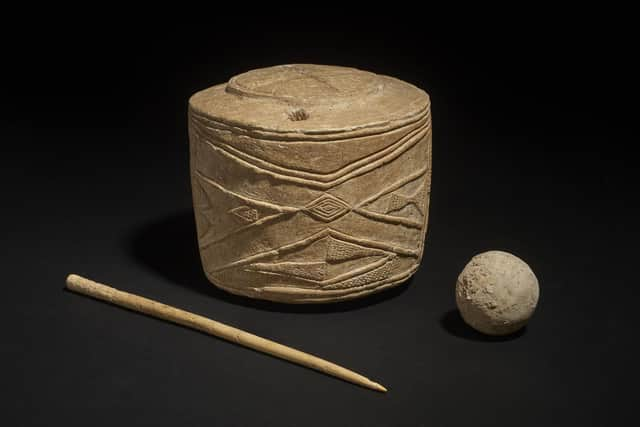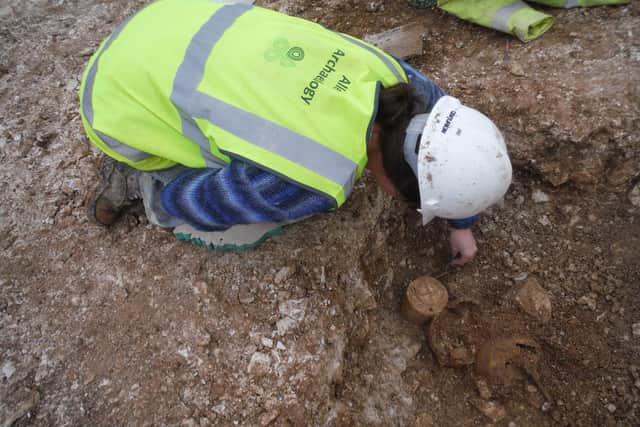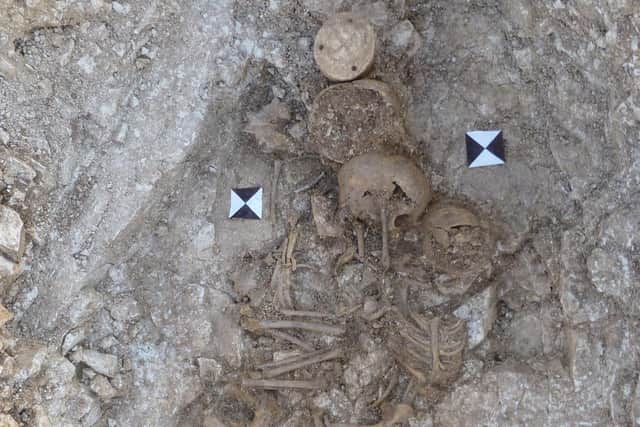Burton Agnes drum: How a young archaeologist found an amazing Neolithic grave on the site of an East Yorkshire biogas plant
Allen Archaeology were contracted to undertake 'routine' excavations on the Burton Agnes estate in East Yorkshire - which has been a manor since Norman times - in 2015 on land that was later developed for the Burton Agnes Renewables plant as part of the planning application process.
The discovery was made by young archaeologist Alice Beasley, then 24, only two years after she had graduated from the University of Bradford.
Advertisement
Hide AdAdvertisement
Hide AdDespite being unearthed seven years ago from a Stone Age children's grave, the drum's existence was only revealed yesterday as part of promotional activity for the British Museum's new exhibition in which it features.


The 5,000-year-old chalk drum sculpture has been studied intensively since 2015, and its discovery has also enabled experts to date its closest 'cousins' - the Folkton drums, which were excavated in the Vale of Pickering in 1889 - for the first time.
It is now one of the most significant Neolithic objects ever found in Britain and will go on display as part of the World of Stonehenge event.
The drum is decorated with elaborate artistic motifs and was buried alongside three children of varying ages. The two youngests' hands were touching and the eldest was holding them. The Folkton drums were found in a single child's grave.


Advertisement
Hide AdAdvertisement
Hide AdThe Burton Agnes example is one of four such 'drums' ever found - though they were not used for music, and instead served a talismanic role.
Carbon dating techniques enabled archaeologists to establish that the Burton Agnes children died between 3005-2890 BC, during the period Stonehenge was built. The reliable data means that the Folkton drums are now thought be 500 years older than first defined, and links different tribes across Britain who were sharing artistic styles and beliefs.
Also found in the Burton Agnes grave were a chalk ball and polished bone pin, which have also been uncovered in Stonehenge excavations. Theories include that they were toys or fertility symbols.
Experts now believe Neolithic society was far more interlinked and less fragmented than has been previously believed.


Advertisement
Hide AdAdvertisement
Hide AdThe Burton Agnes estate - which has been in the same family since the 12th century - retain ownership of the objects and it remains to be seen where they will be displayed after the loan to the British Museum ends.
Alice Beasley, now 31 and from Grimsby, was sent to the site for a 'standard' dig without high expectations, though her team knew there were two Neolithic barrows - or burial mounds - nearby that had never been investigated.
"It was the middle of winter and the weather was terrible. To find something so rare is incredible. We uncovered the skeletons and were clearing around the head when it appeared and we realised we'd found something special. We didn't know what to do so we had to ring the office for some guidance!
"There is a tradition of Neolithic occupation in East Yorkshire with other monuments nearby, but we don't know if those mounds have been moved and we wouldn't just dig up someone's resting place unless we really had to.


Advertisement
Hide AdAdvertisement
Hide Ad"We did make some other finds and a report on them will be coming out later."
British Museum curator Neil Wilkin said: “This is a truly remarkable discovery, and is the most important piece of prehistoric art to be found in Britain in the last 100 years. The Folkton drums have long remained a mystery to experts for well over a century, but this new example finally begins to give us some answers. To my mind, the Burton Agnes drum is even more intricately
carved and reflects connections between communities in Yorkshire, Stonehenge, Orkney and Ireland. Analysis of its carvings will help to decipher the symbolism and beliefs of the era in which Stonehenge was constructed.
“The discovery of the Burton Agnes grave is highly moving. The emotions the new drum expresses are powerful and timeless, they transcend the time of Stonehenge and reflect a moment of tragedy and despair that remains undimmed after 5,000 years. We are honoured that the British Museum will be the first place the public will be able to see this important object, and that they will see it alongside 430 other ancient items telling the spectacular story of Stonehenge and the vibrant world in which it was built.”
Advertisement
Hide AdAdvertisement
Hide AdAllen Archaeology director Mark Allen added: “It has been a real privilege to have been involved in this amazing discovery, and I would like to take this opportunity to thank the landowners for their enthusiasm and interest in the project from the outset. When we heard about the find from the team on site and saw the photos of the drum that were messaged over to us, it was clear we were looking at something extraordinary, although the photos did not do it justice, and we were all stunned to see it up close when it came off site.
"The detailed relief carving on the drum is quite something to behold and shows great skill by its maker. Research is ongoing on the drum, the burials and the surrounding excavations, and we look forward to publishing more on this in the future.
